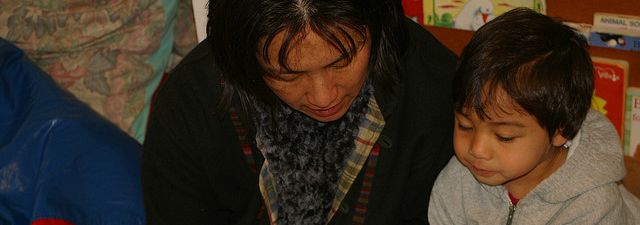relationships with families

- Discuss the current strategies the teacher uses to communicate with families. Make a list noting the direction of the communication. Brainstorm ways to enhance two-way communication with families. (Office of Head Start: Program Preparedness Checklist:
Serving Dual Language Learners and Their Families)
- Gather two or more teachers to share strategies about ways to use the family culture to create a bridge between the program and the home. Discuss ways to support the children’s pride in their family experiences and to understand individual differences in background and viewpoint. Talk about ways to encourage parents and family members to share talents, skills, and cultural practices with staff, the children in the program, and other families. (PCF, p. 80; PEL, p. 16)
- Share with teachers how children may have different ways of speaking and listening based on what is acceptable within cultural backgrounds. For example, in some cultures interrupting someone who is speaking is considered rude, whereas in others that behavior is acceptable. Suggest that the teacher ask family members or knowledgeable community resources to share appropriate social conventions for the child’s language and culture. Remind the teacher to observe the child during drop-off and pick up for cues about the social rules used in the home language. Teachers may want to make note of the following: How do parents respond to their child? What is the physical proximity of between the parent and the child? How animated is the parent when she is speaking? What is the child’s reaction? (Prekindergarten Learning & Development Guidelines, p. 43; PCF, p. 200)
- Ask teachers to think about the ways they connect school language and literacy practices to the home, culture and community. Elicit the strategies they use to find out as much as possible about the children’s home life, family activities, and personal interests. (PCF, p. 207)
- Discuss ways that existing tools could be used or modified to obtain information about children’s language backgrounds, families’ expectations for children’s education, and children’s home, children’s strengths and needs. Discuss how collecting this information would be useful for teachers and families. (PCF, p. 207; PEL, pp.13, 16)
- Provide teachers with a copy of the "Survey of Home Literacy and/or Oral Language Activities" (Handout 1B). Review the tools and discuss the purpose of each. Ask teachers to brainstorm ways to modify and/or use the surveys and the data they yield. (Preschool English Learners Training Manual--Chapter 8)
- Invite a group of teachers to share culturally and linguistically appropriate strategies for regular family communication about children’s progress, preschool activities, and any concerns they may have. Include pictures of documentation displays, photo albums and examples of children’s work portfolios as additional ways to engage parents and family members in meaningful conversation. (PCF, p. 80)
- Have teachers share the strategies they use to provide families with communication in their home language(s). Create a list of program and community resources for translation. (PCF, p. 204: PEL, p. 16)
- Suggest that teachers visit children’s home and observe not only how parents interact with the child but also how other relatives and siblings talk to the child and how the child talks to them. (PEL, p. 29)
- Ask teachers to read the article,"Reading Their Worlds: Working with Diverse Families to Enhance Children’s Early Literacy Development" (Ordonez-Jasis & Ortiz, 2007). After reading the article, have teacher use the “Basics for a Family Survey” to create a survey for the families in the program. (NAEYC, Young Children)
- Give the teacher the links to download "Supporting Early Literacy" (from Washington Learning Systems) in both English and Spanish. Discuss with teachers how they can use these materials with parents to support early language and literacy development, dialogic reading, and C.A.R. strategies.
